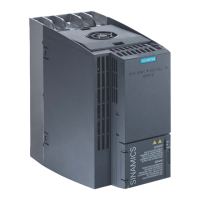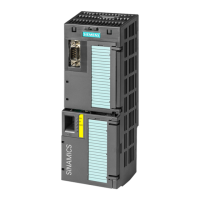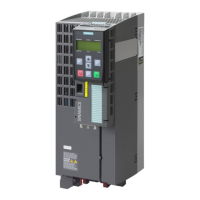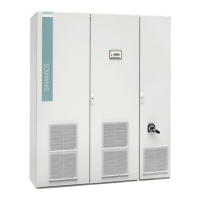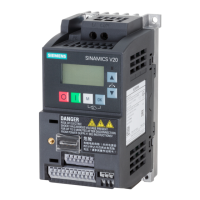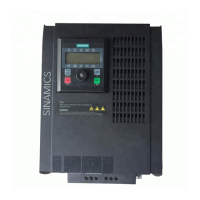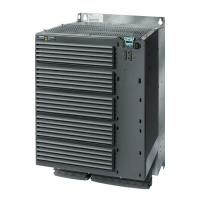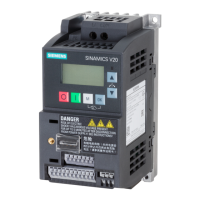Do you have a question about the Siemens SINAMICS G120C PN and is the answer not in the manual?
Provides essential safety guidelines for operating electrical devices and handling potential hazards.
Lists residual risks emanating from control and drive components that must be considered in risk assessment.
Guidance on subdividing control cabinets and machines into EMC zones for reliable operation.
Explains how to connect the line supply, motor, and braking resistor, including system types and requirements.
Provides an overview of interfaces and details connection options for FSAA/FSC and FSD/FSF frame sizes.
Explains communication via PROFINET IO and Ethernet, including RT and IRT functions.
Provides a step-by-step overview for commissioning the drive, from requirements definition to saving settings.
Describes operator panels (IOP-2, BOP-2), Smart Access, and PC tools (STARTER, Startdrive).
Covers collecting motor data, understanding factory settings, and operating the motor.
Details the procedure for quick commissioning using the BOP-2 operator panel.
Guides on performing quick commissioning using a PC with Startdrive software.
Explains when and how to reset the converter to factory settings, with or without safety functions.
Details recommended memory cards and procedures for automatic and manual uploads.
Explains how to activate and deactivate write protection to prevent unauthorized changes.
Details know-how protection to prevent unauthorized reading and copying of converter settings.
Provides step-by-step instructions for activating and deactivating know-how protection using passwords.
Provides a functional overview of the converter, including drive control, safety functions, and motor control.
Explains the sequence control rules for switching the motor on and off, including converter states.
Explains the use and connection of failsafe digital inputs for safety functions.
Provides instructions for connecting and configuring PROFIBUS communication.
Explains drive control using Modbus RTU for cyclic process and acyclic parameter data transfer.
Details drive control using USS for cyclic process and acyclic parameter data transfer.
Explains drive control using Ethernet/IP for cyclic process and acyclic parameter data transfer.
Details how to switch over master control and manage command data sets for different settings.
Explains the function of the motor holding brake and its commissioning.
Details the STO safety function, its principle of operation, and commissioning procedures.
Covers commissioning tools (Startdrive) and password protection for safety functions.
Describes the converter self-test for safety functions and its monitoring time.
Covers acceptance testing of safety-relevant functions and components, including documentation.
Explains how the converter receives setpoints from various sources like fieldbus or analog inputs.
Describes functions influencing setpoints, such as invert, inhibit direction, and skip frequency bands.
Details the PID controller's implementation, basic settings, and controller parameter adjustment.
Explains the autotuning function for automatic optimization of the PID technology controller.
Covers methods for ensuring motor speed follows setpoints, including U/f control and vector control.
Describes the structure of sensorless vector control and its closed-loop operations.
Guides on optimizing speed control response, including manual adjustment and critical applications.
Covers electrical braking methods: DC braking, compound braking, and dynamic braking.
Explains how the I-max controller prevents high motor current and manages acceleration/deceleration.
Covers converter temperature monitoring, overload responses, and thermal protection.
Describes motor protection using KTY84, temperature switches, PTC, and Pt1000 sensors.
Explains motor temperature calculation using thermal models and their response.
Guides on achieving motor overload protection using thermal models and parameter adjustments.
Details protection against overvoltage by monitoring DC link voltage and limiting output voltage.
Provides an overview of diagnostic types: LEDs, alarms, faults, and I&M data.
Explains alarms, their properties, and how they are stored in the alarm buffer and history.
Covers faults, their properties, and how they are stored in the fault buffer and history.
Provides a list of common alarms and faults with their causes and remedies.
Details preconditions and procedures for replacing a converter with a different type.
Explains how to download settings from memory cards or PC using Startdrive.
Covers procedures for upgrading and downgrading the converter firmware.
Troubleshooting steps for when the converter does not respond to commands.
Explains EMC requirements, environments, categories, and measures for compatibility.
Provides essential safety guidelines for operating electrical devices and handling potential hazards.
Lists residual risks emanating from control and drive components that must be considered in risk assessment.
Guidance on subdividing control cabinets and machines into EMC zones for reliable operation.
Explains how to connect the line supply, motor, and braking resistor, including system types and requirements.
Provides an overview of interfaces and details connection options for FSAA/FSC and FSD/FSF frame sizes.
Explains communication via PROFINET IO and Ethernet, including RT and IRT functions.
Provides a step-by-step overview for commissioning the drive, from requirements definition to saving settings.
Describes operator panels (IOP-2, BOP-2), Smart Access, and PC tools (STARTER, Startdrive).
Covers collecting motor data, understanding factory settings, and operating the motor.
Details the procedure for quick commissioning using the BOP-2 operator panel.
Guides on performing quick commissioning using a PC with Startdrive software.
Explains when and how to reset the converter to factory settings, with or without safety functions.
Details recommended memory cards and procedures for automatic and manual uploads.
Explains how to activate and deactivate write protection to prevent unauthorized changes.
Details know-how protection to prevent unauthorized reading and copying of converter settings.
Provides step-by-step instructions for activating and deactivating know-how protection using passwords.
Provides a functional overview of the converter, including drive control, safety functions, and motor control.
Explains the sequence control rules for switching the motor on and off, including converter states.
Explains the use and connection of failsafe digital inputs for safety functions.
Provides instructions for connecting and configuring PROFIBUS communication.
Explains drive control using Modbus RTU for cyclic process and acyclic parameter data transfer.
Details drive control using USS for cyclic process and acyclic parameter data transfer.
Explains drive control using Ethernet/IP for cyclic process and acyclic parameter data transfer.
Details how to switch over master control and manage command data sets for different settings.
Explains the function of the motor holding brake and its commissioning.
Details the STO safety function, its principle of operation, and commissioning procedures.
Covers commissioning tools (Startdrive) and password protection for safety functions.
Describes the converter self-test for safety functions and its monitoring time.
Covers acceptance testing of safety-relevant functions and components, including documentation.
Explains how the converter receives setpoints from various sources like fieldbus or analog inputs.
Describes functions influencing setpoints, such as invert, inhibit direction, and skip frequency bands.
Details the PID controller's implementation, basic settings, and controller parameter adjustment.
Explains the autotuning function for automatic optimization of the PID technology controller.
Covers methods for ensuring motor speed follows setpoints, including U/f control and vector control.
Describes the structure of sensorless vector control and its closed-loop operations.
Guides on optimizing speed control response, including manual adjustment and critical applications.
Covers electrical braking methods: DC braking, compound braking, and dynamic braking.
Explains how the I-max controller prevents high motor current and manages acceleration/deceleration.
Covers converter temperature monitoring, overload responses, and thermal protection.
Describes motor protection using KTY84, temperature switches, PTC, and Pt1000 sensors.
Explains motor temperature calculation using thermal models and their response.
Guides on achieving motor overload protection using thermal models and parameter adjustments.
Details protection against overvoltage by monitoring DC link voltage and limiting output voltage.
Provides an overview of diagnostic types: LEDs, alarms, faults, and I&M data.
Explains alarms, their properties, and how they are stored in the alarm buffer and history.
Covers faults, their properties, and how they are stored in the fault buffer and history.
Provides a list of common alarms and faults with their causes and remedies.
Details preconditions and procedures for replacing a converter with a different type.
Explains how to download settings from memory cards or PC using Startdrive.
Covers procedures for upgrading and downgrading the converter firmware.
Troubleshooting steps for when the converter does not respond to commands.
Explains EMC requirements, environments, categories, and measures for compatibility.
| Power range | 0.55 kW to 132 kW |
|---|---|
| Control type | Vector control, V/f control |
| Protection class | IP20 |
| Ambient temperature range | -10 °C to +50 °C |
| Product type designation | SINAMICS G120C |
| Integrated Safety | STO (Safe Torque Off) |
| Operating Temperature | -10 °C to +50 °C |
| Storage temperature range | -40 °C to +70 °C |
| Communication interfaces | PROFINET |
| Output voltage range | 0 V to input voltage |
| Overload Capacity | 150% for 60 s |
| Relative humidity | 5% to 95%, non-condensing |
| Altitude | Up to 2000 m without derating |
